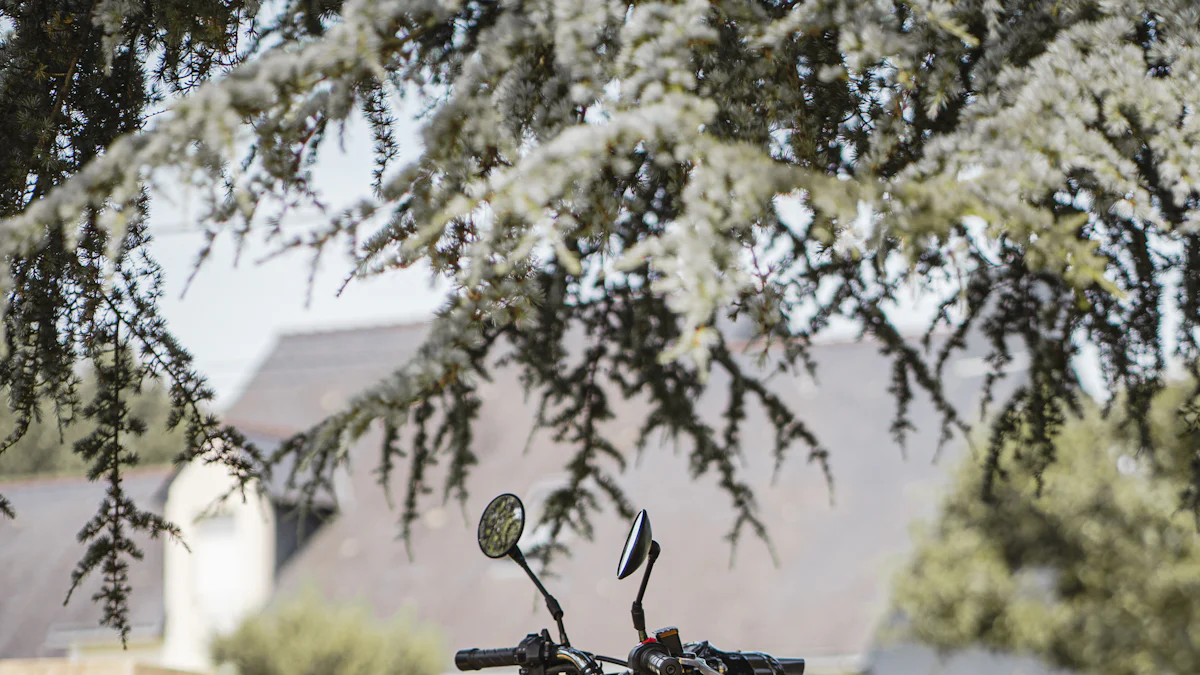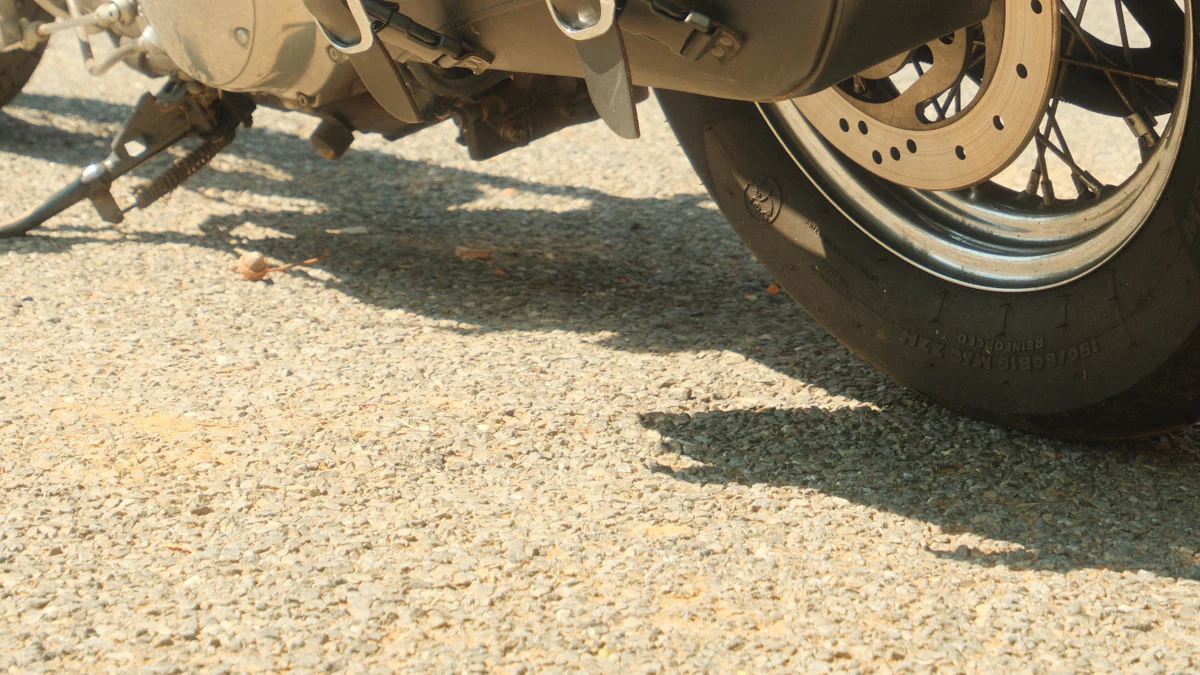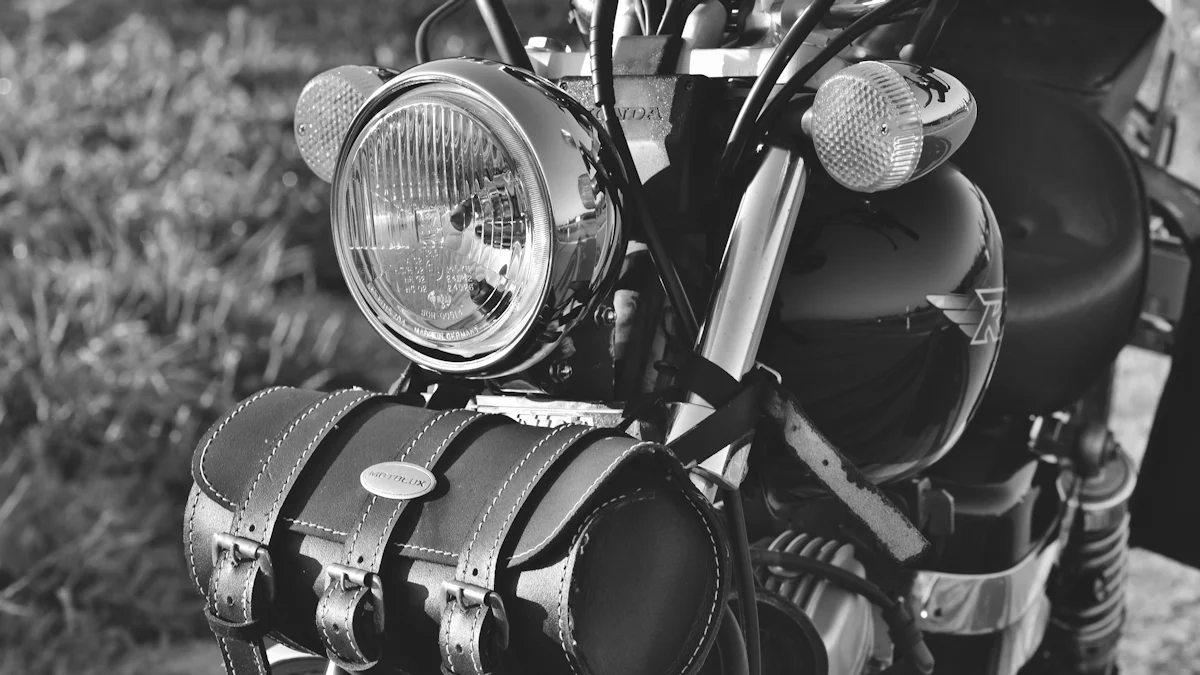How to Install a Harley Davidson Saddlebag Step by Step
Table of Contents
-
Motorcycle Flag Mounts
Motorcycle 1 1/4″ Highway Engine Guard Crash Bar For Harley Sportster XL 1200 883 2004-2021
$149.99 – $259.99Price range: $149.99 through $259.99 This product has multiple variants. The options may be chosen on the product pageRated 0 out of 5 -
Motorcycle Flag Mounts
Motorcycle LED Saddlebag Lid Spoiler Kit For Harley Touring Road King Electra Glide Street Road Glide 2014-2024
$67.99Rated 0 out of 5 -
Flag Mounts & Flags
2Pack Support Breast Cancer Awareness with Stylish Harley Davidson Motorcycle Flags
$19.99Rated 0 out of 5 -
Flag Mounts & Flags
2Pack Breast Cancer Awareness Harley DavidsonMotorcycle Flag – Ride with Purpose
$19.99Rated 0 out of 5

Installing a Harley Davidson saddlebag isn’t just about adding storage—it’s about ensuring safety and balance on the road. To effectively install a Harley Davidson saddlebag, you need to ensure that it keeps your gear secure and prevents shifting that could affect your ride. You’ll need to position it carefully to avoid interfering with your legs or the bike’s handling. Using the right tools and techniques, you can protect your motorcycle’s finish while achieving a stable fit. Once installed, test the load by taking short rides to confirm everything stays in place. With the right approach, you’ll enjoy both convenience and peace of mind.
Key Takeaways
Gather the right tools and materials before starting the installation to ensure a smooth process and protect your motorcycle.
Carefully align and secure the mounting brackets to prevent instability during rides; use a torque wrench to tighten bolts to the manufacturer’s specifications.
Position the saddlebag correctly to avoid interference with other components, ensuring proper spacing for safety and functionality.
Regularly inspect and maintain the saddlebag installation by checking for loose bolts and cleaning to prevent damage from dirt and debris.
Consider model-specific requirements for your Harley Davidson to ensure compatibility and a secure fit during installation.
Enhance your riding experience by adding optional accessories like backrests and luggage racks, ensuring they are compatible with your saddlebag setup.
Test the stability of your saddlebag after installation with short rides, making adjustments as necessary for a secure and balanced fit.
Tools and Preparation

Before diving into the installation process, it’s essential to gather the right tools and materials. Proper preparation ensures a smooth and hassle-free experience while protecting your motorcycle from unnecessary damage.
Tools Required
To install your Harley Davidson saddlebag, you’ll need a few basic tools. These tools help you secure the saddlebag firmly and ensure a professional finish:
Wrenches, screwdrivers, and Allen keys: These are essential for tightening bolts and screws during the installation process. Make sure you have a variety of sizes to match the hardware in your saddlebag kit.
Torque wrench: This tool ensures you tighten bolts to the correct specifications, preventing over-tightening or loose fittings.
Thread locker: Use this to secure bolts and prevent them from loosening due to vibrations while riding.
Pro Tip: If you don’t already own these tools, consider investing in a complete set like the Tools for Saddlebag Installation kit, which includes wrenches, hex keys, and screwdrivers.
Materials Needed
Having the right materials on hand is just as important as having the right tools. Here’s what you’ll need:
Saddlebag kit: This kit typically includes the saddlebags, mounting brackets, and all necessary hardware. Make sure the kit is compatible with your Harley Davidson model.
Model-specific mounting instructions: Some saddlebag kits come with detailed instructions tailored to your bike. These can save you time and ensure proper installation.
If your kit doesn’t include instructions, check online forums or the manufacturer’s website for guidance. Many riders share helpful tips and tricks for specific models.
Preparation Steps
Taking the time to prepare your motorcycle will make the installation process much easier. Follow these steps to get started:
Check compatibility: Ensure the saddlebag kit matches your Harley Davidson model. Double-check the mounting points and hardware to avoid surprises during installation.
Remove interfering components: Take off any parts that might get in the way, such as the seat or rear fender. This gives you better access to the mounting area.
Clean the mounting area: Wipe down the area where the brackets will attach. Dirt or debris can affect the fit and stability of the saddlebag.
Quick Tip: Use a soft cloth and mild cleaner to avoid scratching your bike’s finish. For added protection, tape off surrounding areas before starting the installation.
By gathering the right tools, materials, and preparing your motorcycle, you’re setting yourself up for a successful saddlebag installation. Taking these steps ensures a secure fit and a stress-free ride.
Step-by-Step Installation Guide

Installing a Harley Davidson saddlebag requires careful attention to detail. Follow these steps to ensure a secure and professional installation.
Step 1: Attach the Mounting Brackets
The first step is to set up the foundation for your saddlebag. The mounting brackets are essential for keeping the saddlebag stable and aligned.
Align the brackets with the designated mounting points
Locate the pre-drilled holes or mounting points on your motorcycle. These are usually near the rear fender or frame. Hold the brackets in place and ensure they align perfectly with these points. Misalignment can cause instability during rides.Secure the brackets using the provided bolts
Use the bolts included in your saddlebag kit to attach the brackets. Tighten them with a wrench or Allen key, but avoid over-tightening at this stage. You’ll make final adjustments later.
Pro Tip: Apply a small amount of thread locker to the bolts before tightening. This prevents them from loosening due to vibrations while riding.
Step 2: Position the Saddlebag
Once the brackets are in place, it’s time to position the saddlebag. This step ensures the bag sits correctly and doesn’t interfere with other components.
Align the saddlebag with the installed brackets
Place the saddlebag against the brackets. Check that the mounting holes on the bag line up with the holes on the brackets. Adjust as needed to achieve a perfect fit.Ensure proper spacing to avoid interference with other components
Make sure there’s enough space between the saddlebag and parts like the exhaust pipe or rear wheel. This prevents heat damage and ensures smooth operation of your bike.
Quick Tip: If you’re installing a saddlebag on one side only, double-check the balance of your motorcycle. Uneven weight distribution can affect handling.
Step 3: Secure the Saddlebag
With the saddlebag in position, the next step is to lock it in place. This ensures it stays secure even on bumpy roads.
Use the provided hardware to attach the saddlebag to the brackets
Insert the screws or bolts through the mounting holes on the saddlebag and into the brackets. Use the hardware included in your kit for the best fit.Tighten bolts to the recommended torque specifications
Use a torque wrench to tighten the bolts to the manufacturer’s specifications. This step is crucial for safety. Over-tightening can damage the hardware, while under-tightening can cause the saddlebag to come loose.
Safety Tip: After securing the saddlebag, give it a gentle shake to test its stability. If it moves, recheck the bolts and brackets.
By following these steps, you can confidently install a saddlebag on your Harley Davidson. Proper installation not only enhances your bike’s functionality but also ensures your safety on the road. Take your time, use quality tools, and double-check your work for the best results.
Step 4: Final Adjustments
Now that your saddlebag is mounted, it’s time to fine-tune the setup. These final adjustments ensure everything stays secure and aligned for a safe and smooth ride.
Check alignment and spacing
Start by inspecting the saddlebag’s position. Look at it from different angles to confirm it’s straight and evenly aligned with the motorcycle. Misalignment can affect the bike’s balance and handling, especially when carrying heavier loads.
Verify spacing: Make sure there’s enough clearance between the saddlebag and nearby components like the exhaust pipe, rear wheel, or suspension. Insufficient spacing can lead to heat damage or unwanted friction.
Test the fit: Gently push and pull the saddlebag to check for any movement. A properly mounted saddlebag should feel stable and secure.
Quick Tip: If you mount a single saddlebag on one side, double-check the weight distribution. Uneven weight can make the bike harder to control, so consider balancing it with a similar load on the other side.
Apply thread locker to bolts for added security
Once you’re satisfied with the alignment, it’s time to lock everything in place. Vibrations from the road can loosen bolts over time, so applying a thread locker is a smart way to prevent this.
Choose the right thread locker: Use a medium-strength thread locker that allows for future adjustments but keeps bolts secure during rides.
Apply carefully: Remove one bolt at a time, apply a small amount of thread locker to the threads, and then tighten it back to the recommended torque. Repeat this process for all bolts.
Pro Tip: Avoid over-tightening the bolts after applying the thread locker. Follow the torque specifications provided in your saddlebag kit to prevent damage to the hardware.
After completing these adjustments, take your bike for a short test ride. Pay attention to how the saddlebag feels and listen for any unusual noises. If everything checks out, you’re ready to hit the road with confidence.
Model-Specific Notes
When installing saddlebags on your Harley Davidson, you’ll find that different models have unique requirements. Paying attention to these specifics ensures a secure fit and avoids potential issues during rides. Let’s break it down by model.
Harley Davidson Softail
The Softail series stands out for its sleek design and hidden rear suspension. However, this design introduces some unique challenges when mounting saddlebags.
Unique mounting points and bracket requirements
Softail models, including the 2019 Softail models, feature distinct mounting points that differ from other Harley Davidson bikes. You’ll need brackets specifically designed for Softail frames. These brackets align with the bike’s pre-drilled holes, ensuring a snug and stable fit. Always double-check that your saddlebag kit includes Softail-compatible hardware.
Quick Tip: If you’re working with 2019 Softail models, consult the manufacturer’s instructions or online forums for additional guidance. Many riders share valuable insights about the best brackets and techniques for these bikes.
Tips for avoiding interference with the rear suspension
The hidden rear suspension on Softail bikes can create clearance issues. To avoid interference, position the saddlebag carefully and leave enough space between the bag and the suspension components. This prevents friction and ensures smooth operation.
Inspect the spacing: After mounting the brackets, check the gap between the saddlebag and the suspension. Adjust as needed to maintain proper clearance.
Test the suspension movement: Push down on the bike to simulate suspension compression. Ensure the saddlebag doesn’t come into contact with any moving parts.
Pro Tip: If you mount a single saddlebag on one side of your Softail, balance the weight with a similar load on the other side. This keeps the bike stable and easier to handle.
Harley Davidson V-Rod
The V-Rod’s unique frame design and sporty build require special attention during saddlebag installation.
Considerations for the bike’s frame design
The V-Rod features a distinctive frame that may not accommodate standard saddlebag brackets. Look for brackets designed specifically for the V-Rod’s frame geometry. These brackets ensure a secure fit without compromising the bike’s aesthetics or functionality.
Choose compact saddlebags: The V-Rod’s slim profile works best with smaller saddlebags. Oversized bags may disrupt the bike’s balance and handling.
Align carefully: Position the brackets to match the frame’s contours. Misalignment can lead to instability and uneven weight distribution.
Additional hardware that may be required
Some V-Rod models may need extra hardware, such as spacers or custom brackets, to achieve a proper fit. Check your saddlebag kit for compatibility and purchase additional components if necessary.
Quick Tip: Visit online forums or watch video tutorials for tips on installing saddlebags on V-Rod models. Many riders share step-by-step guides that can save you time and effort.
Other Models
Harley Davidson offers a wide range of models, each with its own set of requirements. Here’s a quick guide to help you navigate the most common ones:
For Touring models, ensure compatibility with the detachable docking hardware.
Touring models often come with detachable docking hardware. Before installing saddlebags, confirm that your kit works with this system. Detachable hardware allows you to remove the bags easily when not in use, adding versatility to your setup.
For Sportster models, consider the smaller frame size and use compact saddlebags.
Sportster bikes have a smaller frame, making compact saddlebags the ideal choice. Larger bags may not fit properly and could interfere with the bike’s handling. Look for lightweight options that match the Sportster’s agile design.
For Dyna models, check for pre-drilled mounting points and use appropriate brackets.
Dyna models typically feature pre-drilled mounting points, simplifying the installation process. Use brackets designed for Dyna frames to ensure a secure fit. Double-check the alignment to avoid any issues during rides.
Pro Tip: No matter the model, always test the stability of your saddlebags after installation. Take a short ride and make adjustments until the bags feel completely stable and secure.
By understanding the specific needs of your Harley Davidson model, you can achieve a seamless saddlebag installation. Whether you ride a Softail, V-Rod, or another model, taking the time to get it right ensures safety, functionality, and style.
Optional Accessories
Adding optional accessories to your Harley Davidson can elevate both comfort and functionality. These additions not only enhance your riding experience but also complement your saddlebag installation. Let’s explore some popular options.
Backrests
Benefits of adding a backrest for passenger comfort
A backrest can transform long rides into a more enjoyable experience for your passenger. It provides essential support, reducing fatigue and improving posture during extended trips. Passengers feel more secure with a backrest, especially when riding at higher speeds or on uneven roads.
Quick Tip: Look for backrests with padded designs for maximum comfort. Adjustable options allow you to customize the height and angle to suit your passenger’s needs.
Compatibility with saddlebag installation
When installing a backrest alongside saddlebags, you need to ensure compatibility. Many Harley Davidson models feature detachable docking hardware that supports both accessories. This setup allows you to install and remove the backrest without interfering with the saddlebags.
Check your model: Verify that your bike’s docking hardware accommodates both the backrest and saddlebags.
Choose the right backrest: Opt for a model-specific backrest designed for your Harley Davidson. This ensures a seamless fit and avoids any conflicts with the saddlebag brackets.
Pro Tip: If you’re unsure about compatibility, consult the manufacturer’s instructions or visit a Harley Davidson dealership for expert advice.
Luggage Racks
Enhancing storage capacity with a luggage rack
A luggage rack is a practical addition for riders who need extra storage. It provides a sturdy platform for securing additional gear, such as duffel bags or camping equipment. Combining a luggage rack with saddlebags maximizes your bike’s carrying capacity, making it ideal for long-distance trips.
Lightweight and durable: Choose a luggage rack made from high-quality materials like stainless steel or aluminum. These materials offer strength without adding unnecessary weight.
Compact design: Look for racks with a low-profile design to maintain your bike’s sleek appearance.
Quick Tip: Use bungee cords or cargo nets to secure items on the luggage rack. This prevents shifting during rides and keeps your gear safe.
Installation tips for combining with saddlebags
Installing a luggage rack alongside saddlebags requires careful planning. You’ll need to ensure both accessories fit without obstructing each other.
Position the luggage rack: Mount the rack above or behind the saddlebags, depending on your bike’s design.
Check clearance: Ensure there’s enough space between the rack and the saddlebags to avoid friction or damage.
Secure the hardware: Use the provided bolts and brackets to attach the rack firmly. Double-check the alignment to maintain balance.
Pro Tip: Some luggage racks are designed to work specifically with Harley Davidson saddlebags. Look for these options to simplify the installation process.
Additional Brackets
When to use extra brackets for added stability
Extra brackets can provide additional support for your saddlebags, especially if you carry heavy loads. They help distribute weight evenly and reduce strain on the mounting points. Consider using extra brackets if:
You frequently ride on rough terrain.
Your saddlebags carry tools, equipment, or other heavy items.
You notice any wobbling or instability after installation.
Quick Tip: Always choose brackets compatible with your Harley Davidson model to ensure a secure fit.
Recommended brands or kits
Several brands offer high-quality brackets designed for Harley Davidson motorcycles. These kits often include all the necessary hardware for easy installation. Some popular options include:
Harley-Davidson Genuine Parts: Known for their perfect fit and durability.
Kuryakyn: Offers versatile brackets compatible with various Harley models.
Cobra USA: Provides heavy-duty brackets ideal for touring and long-distance rides.
Pro Tip: Check online reviews and forums to find the best brackets for your specific model. Riders often share valuable insights and recommendations.
By adding these optional accessories, you can enhance your Harley Davidson’s functionality and comfort. Whether you’re upgrading for passenger support, extra storage, or added stability, these additions make every ride more enjoyable and practical.
Final Checks and Maintenance Tips
Before hitting the road with your newly installed Harley Davidson saddlebags, take a moment to ensure everything is secure and ready for the journey. A quick inspection now can save you from potential issues later. Additionally, regular maintenance will keep your saddlebags in top condition for years to come.
Installation Checklist
Verify all bolts are tightened to the correct torque
Double-check every bolt and fastener on your saddlebags. Use a torque wrench to ensure they’re tightened to the manufacturer’s recommended specifications. Properly torqued bolts prevent loosening caused by road vibrations. Loose bolts can lead to instability, which could compromise your safety.
Pro Tip: If you don’t have a torque wrench, consider investing in one. It’s a valuable tool for any motorcycle enthusiast and ensures precision when tightening bolts.
Ensure the saddlebag is securely attached and aligned
Inspect the alignment of your saddlebags. Look at them from different angles to confirm they’re straight and evenly positioned on both sides of the bike. Misaligned saddlebags can affect your motorcycle’s balance, especially when carrying heavy loads. Gently shake the saddlebags to test their stability. If you notice any movement, recheck the brackets and bolts.
Quick Tip: If you’re using soft saddlebags, make sure the straps are tight and secure. Loose straps can cause the bags to shift while riding.
Maintenance Tips
Regularly inspect bolts and brackets for wear or loosening
Over time, bolts and brackets can loosen due to constant vibrations and exposure to the elements. Make it a habit to inspect these components regularly. Look for signs of wear, rust, or damage. Tighten any loose bolts and replace worn-out hardware immediately to maintain a secure fit.
Did You Know? Using a thread locker during installation helps prevent bolts from loosening. Medium-strength thread lockers are ideal for this purpose.
Clean the saddlebag to prevent damage from dirt or debris
Dirt, dust, and road grime can accumulate on your saddlebags, dulling their appearance and potentially causing damage. Clean your saddlebags regularly using a mild cleaner and a soft cloth. Avoid abrasive materials that could scratch the surface. For hard saddlebags, a quick wipe-down after every ride keeps them looking sharp.
Pro Tip: If you ride through muddy or dusty areas, clean your saddlebags more frequently. This prevents buildup that could be harder to remove later.
Apply protective coatings to maintain the saddlebag’s finish
Protective coatings, such as wax or leather conditioner, can help preserve the finish of your saddlebags. For hard saddlebags, use a high-quality automotive wax to protect against UV rays and moisture. For leather saddlebags, apply a leather conditioner to keep the material supple and prevent cracking.
Quick Tip: Always test a small, inconspicuous area before applying any product to your saddlebags. This ensures compatibility and avoids unwanted discoloration.
By following these final checks and maintenance tips, you’ll not only extend the life of your saddlebags but also enhance your overall riding experience. A well-maintained saddlebag not only looks great but also provides reliable storage for all your adventures.
Installing a Harley Davidson saddlebag doesn’t have to feel overwhelming. By following the right steps, you can ensure a secure fit that enhances both safety and functionality. Taking the time to carefully align and tighten the hardware protects your bike’s finish while giving you peace of mind on the road. Saddlebags for Harley Davidson motorcycles not only add storage but also elevate your riding experience with added convenience and style. Once installed, test your setup with short rides and enjoy the freedom of carrying your gear confidently on every journey.
FAQ
What are the benefits of installing saddlebags on my Harley Davidson?
Saddlebags provide a convenient way to carry your gear securely while riding. They help you balance the weight on your motorcycle, improving stability and safety. With properly installed saddlebags, you can bring essential items like tools, clothing, or snacks for long trips. They also enhance your bike’s functionality without compromising its style.
Tip: Hard-mounted saddlebags are especially useful for extended rides. Their rigid structure ensures your belongings stay safe and protected.
Are hard saddlebags better than soft saddlebags?
Hard saddlebags offer more security and durability compared to soft ones. Made from materials like fiberglass or molded plastics, they protect your items from weather and road debris. Hard-mounted saddlebags also stay firmly in place, reducing the risk of them shifting or interfering with the rear wheel.
Soft saddlebags, on the other hand, are lightweight and easier to install. They work well for casual riders who don’t need heavy-duty storage. Your choice depends on your riding needs and preferences.
How do I know if a saddlebag is compatible with my Harley Davidson?
Check the specifications of the saddlebag kit before purchasing. Most kits list the Harley Davidson models they fit. Look for model-specific mounting instructions or brackets included in the kit. If you’re unsure, consult your bike’s manual or reach out to the manufacturer for guidance.
Quick Tip: Online forums and Harley Davidson communities often share compatibility tips for different models.
Can I install saddlebags myself, or should I hire a professional?
You can install saddlebags yourself if you have the right tools and follow the instructions carefully. This guide provides a step-by-step process to make the installation straightforward. However, if you’re not confident in your skills or lack the necessary tools, hiring a professional ensures a secure and proper fit.
How do I maintain my saddlebags after installation?
Regular maintenance keeps your saddlebags in top condition. Clean them frequently to remove dirt and debris. For hard saddlebags, use a mild cleaner and apply a protective wax to maintain their finish. For leather saddlebags, condition the material to prevent cracking. Also, inspect bolts and brackets regularly to ensure they remain tight and secure.
Do saddlebags affect the balance of my motorcycle?
Properly installed saddlebags won’t negatively impact your bike’s balance. In fact, they help distribute weight evenly, especially when carrying heavy loads. Always check the alignment and spacing during installation. If you’re using a single saddlebag, balance the weight with a similar load on the opposite side.
Can I use saddlebags with other accessories like backrests or luggage racks?
Yes, many Harley Davidson models support multiple accessories. Detachable docking hardware allows you to install saddlebags, backrests, and luggage racks simultaneously. Ensure all components are compatible with your bike’s design to avoid interference.
Pro Tip: When combining accessories, double-check the clearance and alignment to maintain stability.
What should I do if my saddlebags feel loose after installation?
If your saddlebags feel loose, recheck the bolts and brackets. Use a torque wrench to tighten them to the recommended specifications. Apply thread locker to prevent bolts from loosening due to vibrations. If the issue persists, inspect the mounting points for damage or misalignment.
Are there specific saddlebags for long-distance rides?
For long-distance rides, hard saddlebags are an excellent choice. Their rigid design keeps your belongings secure, even on rough terrain. Extended saddlebags provide extra storage space, allowing you to carry more gear safely. Look for weather-resistant options to protect your items from rain or dust.
Can I remove my saddlebags easily after installation?
Many Harley Davidson saddlebags come with detachable mounting systems. These allow you to remove the bags quickly when not in use. Detachable saddlebags are ideal for riders who want flexibility without permanent fixtures on their bikes.
Quick Tip: Always follow the manufacturer’s instructions when removing or reattaching saddlebags to avoid damaging the hardware.








